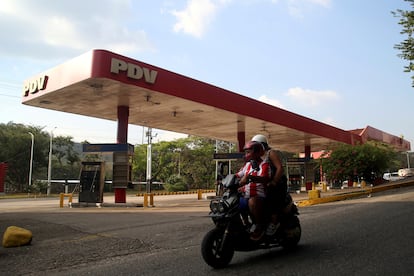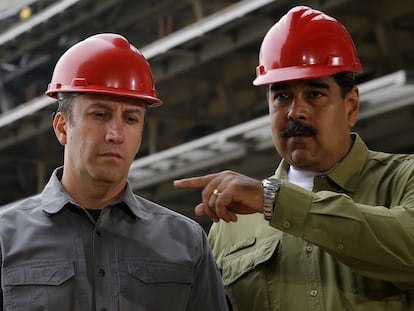Venezuela hit by widespread gasoline shortages
Fuel supply issues are affecting the agricultural heartland and other areas, with lines to refill in some places so long that motorists are forced to sleep in their cars

In recent weeks, Venezuela has been experiencing widespread fuel shortages, particularly in agricultural areas and rural municipalities. The overall issue has been masked by the normal supply reported in some large cities, such as Caracas, Maracaibo and Valencia, but it has worsened in the country’s Eastern Region, Margarita Island, the Guayana region and in other municipalities on the central plains and the Venezuelan Andes. This latest fuel crisis is taking place against the backdrop of an embezzlement case engulfing the state-owned oil company PDVSA, which led to the resignation of former Minister of Petroleum Tareck El Aissami on March 20.
Since the end of last year, a delegation of Iranian technicians has been working with PDVSA on repair and maintenance works at Venezuelan refineries, which have been experiencing chronic failures, explosions and crude oil spills since 2010. The most problematic is the Amuay refinery, one of the largest in the world. Although there have been improvements, technical failures are still being reported and international sanctions have further complicated the maintenance efforts being carried out by the state-owned company.
In the western State of Zulia, historically the center of Venezuela’s oil industry, the two largest cities, Maracaibo and Cabimas, remain largely unaffected but there are significant shortages south of Lake Maracaibo and in northern municipalities such as La Guajira, on the border with Colombia. “Since December, the situation in Maracaibo has been stable. But the gasoline service is critical in towns such as Machiques, La Villa, Santa Barbara, Catatumbo, La Guajira, and Lagunillas, where both gasoline and diesel are almost non-existent. There are no regular deliveries,” says local journalist Madelyn Palmar.
Shortages in Venezuela are nothing new, but the current situation has been affecting parts of the country for months. Ciudad Guayana, which includes the twin cities of Puerto Ordaz and San Felix, and many other towns and villages in Bolivar, the largest state in Venezuela, have been witnessing lines to refuel that can take up to a day to get through: many motorists have taken to “marking their spot” or sleeping inside their vehicles to ensure they can fill their tanks.
On Margarita Island, traffic restrictions have been reintroduced through a rationing parameter by which fuel is assigned to drivers according to license plate numbers and distributed at specific times during the week. “After Carnival, the torture began. The lines are much heavier in places where gasoline is subsidized. The dollarized gas stations are a little more accessible,” says local correspondent Dexcy Guedez. Filling up the tank of an economy car can cost $20.
Leonel Canelón, president of the Association of Food Transportation in the state of Nueva Esparta, which contains Margarita and the islands of Coche and Cubagua, said that shortages are also affecting the fishing fleets, one of the main sources of employment in the area. “Fuel shortages are causing delays to the entry of goods and food to the island,” he added.
In the Andean State of Mérida in northwestern Venezuela, journalist Yoirys Sosa reports that in cities and towns “the lines to get gas are kilometers long; people stay overnight to get fuel and it has affected public transportation and the going about of daily life. Farmers have been particularly affected; around 15,000 workers who produce a large amount of the country’s vegetables.”
Subsidized gasoline stations have been gradually disappearing. It is now commonplace to buy gas at international prices. Until early this century, Venezuela was one of the world’s major exporters of oil and all crude oil derivatives, and its refinery system was a model of good management and administrative efficiency until at least 2002. Venezuelan gasoline was also among the cheapest in the world for several decades: a tank could be filled at a cost of just a few cents.
Sign up for our weekly newsletter to get more English-language news coverage from EL PAÍS USA Edition
Tu suscripción se está usando en otro dispositivo
¿Quieres añadir otro usuario a tu suscripción?
Si continúas leyendo en este dispositivo, no se podrá leer en el otro.
FlechaTu suscripción se está usando en otro dispositivo y solo puedes acceder a EL PAÍS desde un dispositivo a la vez.
Si quieres compartir tu cuenta, cambia tu suscripción a la modalidad Premium, así podrás añadir otro usuario. Cada uno accederá con su propia cuenta de email, lo que os permitirá personalizar vuestra experiencia en EL PAÍS.
¿Tienes una suscripción de empresa? Accede aquí para contratar más cuentas.
En el caso de no saber quién está usando tu cuenta, te recomendamos cambiar tu contraseña aquí.
Si decides continuar compartiendo tu cuenta, este mensaje se mostrará en tu dispositivo y en el de la otra persona que está usando tu cuenta de forma indefinida, afectando a tu experiencia de lectura. Puedes consultar aquí los términos y condiciones de la suscripción digital.
More information
Archived In
Últimas noticias
Maduro pleads not guilty before the federal court in New York: ‘I am still the president of Venezuela’
A new test can detect Alzheimer’s from a finger prick
UN team enters Sudanese city of El Fasher after paramilitary massacre: ‘It’s like a ghost town’
A recipe for resistance: Indigenous peoples politicize their struggles from the kitchen
Most viewed
- Gilles Lipovetsky: ‘If you want to live better and fall in love, take Prozac, don’t look to philosophy’
- Alain Aspect, Nobel laureate in physics: ‘Einstein was so smart that he would have had to recognize quantum entanglement’
- Alvin Hellerstein, a 92-year-old judge appointed by Bill Clinton, to preside over Maduro’s trial in New York
- Maduro’s downfall puts China’s relationship with Venezuela to the test
- Why oil has been at the center of Venezuela-US conflicts for decades










































